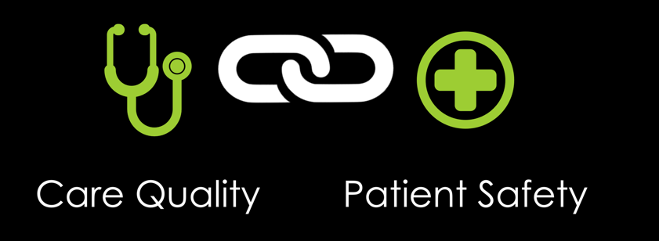Linking Quality and Patient Safety
 Errors in health care are most often the result of system problems rather than of individual acts. Yet, historically, the tendency has been to blame individuals for errors and adverse events. When error is not acknowledged, there is a missed opportunity to learn, to improve patient safety and prevent this from happening again. There is a growing focus on changing the systems and processes that contribute to or influence the occurrence of error or adverse events. As discussed earlier, this attention has led the government in taking leadership in the introduction of policy and legislation, to support patient safety and quality care.
Errors in health care are most often the result of system problems rather than of individual acts. Yet, historically, the tendency has been to blame individuals for errors and adverse events. When error is not acknowledged, there is a missed opportunity to learn, to improve patient safety and prevent this from happening again. There is a growing focus on changing the systems and processes that contribute to or influence the occurrence of error or adverse events. As discussed earlier, this attention has led the government in taking leadership in the introduction of policy and legislation, to support patient safety and quality care.
At the end of this section, the learner will:
- appreciate the transition in philosophy regarding patient safety and the extent this thinking has advanced over recent decades
- how learnings in industry have been applied in health care
- understand how culture, structures, and process influence outcomes such as error and adverse events.
- have an increased awareness of the factors that contribute to risks to patient safety, and the frameworks available to examine these factors
- appreciate the value of engaging patients and families
- understand why it is critical to disclose when errors and adverse events occur and the consequences of not doing so.
Lecture Video: Linking Quality and Patient Safety (21:18)
Slides: Linking Quality and Patient Safety
Activity # 1
Read the following article:
de Jonge V. Sint Nicolaas, J. , Van Leerdam, M., & Kuipers, E. (2011). Overview of the quality assurance movement in health care, Best Practice & Research Clinical Gastroenterology, 25(3), 337-347.
This article provides an excellent overview of the evolution of Quality and Safety in health care and aligns with the objectives of this subtopic. It describes how quality is deeply rooted in the way clinicians practise and that it has made a significant improvement since the last decade. Various models and frameworks are described.
Activity # 2
Review the following video which provides a summary of Reason’s Swiss Cheese Model (Reason, 2000). Having reviewed this model can you think of an example in your environment that would illustrate how this model would work?
Video: Reasons Swiss Cheese Model (3:15)
Activity # 3
Watch this video which highlights how the Reason’s Swiss Cheese Model can be applied to the spread of COVID 19.
Video: This Swiss cheese analogy can help protect you from the coronavirus (COVID-19) (2:43)
Activity # 4
Reflect on whether you have made an error, as a student or as a practising nurse. How was the situation managed by your leader? What do you think contributed to this mistake? Were there any changes introduced in your practice environment to prevent a similar occurrence in the future? If not, on reflection what changes might you have made. Which tools and approaches outlined in the deJonge article might you recommend as a response to this situation? If you are fortunate enough not to have made an error in your career so far, consult with colleagues who may have had this experience and explore the questions with them.
Activity # 5
Watch this video which focuses on patient and family centered care and reflects on the reasons why it is important to engage patients and families to ensure safety and the prevention of harm. Identify 3 key learnings from this video.
Video: Patients for Patient Safety Canada Video (10:56)

